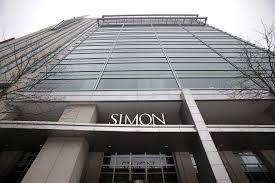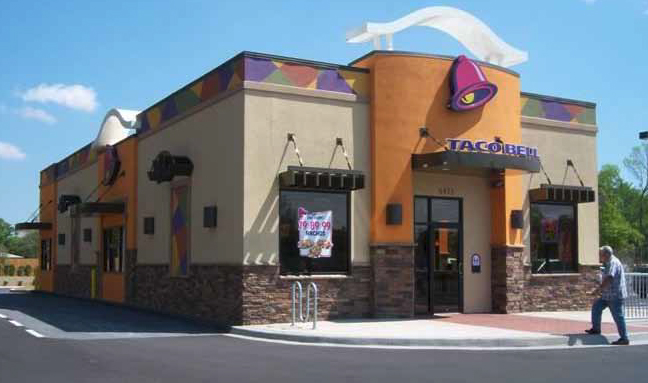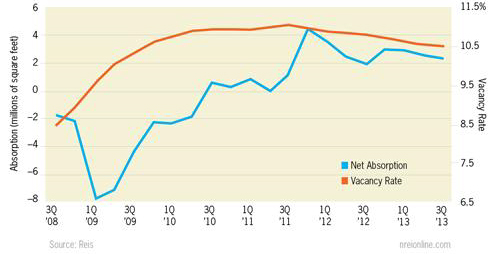

|
207 Abbey Lane Lansdale, Pennsylvania 19446 215-855-1800 |
5201 Ocean Avenue #2007 Wildwood, New Jersey 08260 215-990-6663 |
Specializing in Real Estate Appraisal and Property Tax Consulting
A Professional Courtesy of:
|

Specializing in Real Estate Appraisal and Property Tax Consulting |
| WINTER 2014 |
 |
|
In This Issue:
|
|
Simon to Spin Off Malls & Centers  On December 13, 2013, the 20th anniversary of Simon Property Group, Inc. (NYSE: SPG) becoming a publicly traded company, CEO David Simon announced that the company plans a spinoff to existing shareholders 44 smaller malls and all 54 strip and open-air power centers into SpinCo. Initially 70% of SpinCo net operating income, or NOI, will come from malls with the remaining 30% from the open-air centers. During the companyís conference call, Mr. Simon made it clear that the open-air component will be the focus for SpinCo new development and growth. Additionally, some of the smallest mall properties may be sold as well.
On December 13, 2013, the 20th anniversary of Simon Property Group, Inc. (NYSE: SPG) becoming a publicly traded company, CEO David Simon announced that the company plans a spinoff to existing shareholders 44 smaller malls and all 54 strip and open-air power centers into SpinCo. Initially 70% of SpinCo net operating income, or NOI, will come from malls with the remaining 30% from the open-air centers. During the companyís conference call, Mr. Simon made it clear that the open-air component will be the focus for SpinCo new development and growth. Additionally, some of the smallest mall properties may be sold as well.The move by Simon is unusual because most new publicly traded companies come via initial public stock offerings from existing companies seeking more working capital. Simonís plan will birth a ready-to-go, staffed-up and well-financed company valued near $6 billion. Its main assets will be 54 strip centers and 44 malls in 23 states. Publicly traded Simon, which started up in Indianapolis in 1960 and is one of the nationís largest operators and developers of shopping centers, said the spinoff will let it focus on its most-prized assets, its large regional malls and outlet centers, plus international expansion. The spinoff will slim Simonís portfolio by a third. Simonís board opted not to sell the strip centers and smaller malls to the highest bidder, partly because a sale would be a taxable event for shareholders. The spinoff wonít be taxable and will give shareholders stock in the new company and a chance to share in any growth. Simon chose to use NOI of less than $10 million per year as the metric to decide which malls to be included in the spin-off. But in addition to the 36.4 million square feet of mall space, SpinCo also has 16.6 million square feet of power/strip centers. There really isnít another REIT with a similar dual asset class mix. Occupancy of properties that will be deeded to SpinCo is more than 90 percent. Although many are in smaller cities with limited population growth, the properties as a whole have significant expansion potential, with more than $300 million of development opportunity. Top management for SpinCo, including its CEO, will be named in the first quarter. Its board of five to nine members will include David Simon and Richard Sokolov, President and COO of SPG, who will be chairman. This 1:1 share spinoff seems like a great idea for existing SPG shareholders. When the SpinCo Form 10 is filed with the SEC, there will be more information for all investors to evaluate. Analysts will be looking closely at the SpinCo mall component. SPG will have to prove that its new business model - own higher quality properties while maintaining a strong balance sheet - can provide long-term investors with excellent risk adjusted returns. |
Retail Cap Rates at Historic Lows During the past year, the cap rates for most single-tenant net-leased properties have hovered around historic lows, but in the final quarter, rates for retail and office sank even lower. In fact, new research shows retail and office rates hit their lowest levels in the past decade. However, cap rates for net-leased industrial properties did increase. According to a new report by The Boulder Group, a commercial real estate firm in suburban Chicago, rates for retail sank from 7.02% in the third quarter to 6.85% in the fourth quarter, and for the first time in the past decade the sector's rate fell below 7.0%. In comparison, rates for office properties fell from 7.7% to 7.4%, also a decade low, and cap rates for industrials grew from 8.0% to 8.15%. "Investors' perception was that cap rates would follow the rising interest rate climate; however this correlation did not occur," the report notes. "Supply constraints remain a primary factor to the current cap rate levels within the net lease market." Boulder officials believe that with so many institutional investors and real estate funds trying to hit year-end acquisition targets, the supply of available properties decreased. In addition, "investors were able to refinance at historically low rates which allowed single tenant property owners to hold rather than sell."
"Investors' perception was that cap rates would follow the rising interest rate climate; however this correlation did not occur," the report notes. "Supply constraints remain a primary factor to the current cap rate levels within the net lease market." Boulder officials believe that with so many institutional investors and real estate funds trying to hit year-end acquisition targets, the supply of available properties decreased. In addition, "investors were able to refinance at historically low rates which allowed single tenant property owners to hold rather than sell."Boulder also recently conducted a national survey of those participating in the net-leased market, and the largest group of those surveyed believes cap rates will rise more than 25 bps by the end of 2014. As might be expected, the most cited reason by participants was the expectation that interest rates will increase. |
Mall Vacancy Slowly Improving Malls have generally experienced a stronger recovery relative to smaller shopping centers; national vacancies peaked at 9.4 percent in the third quarter of 2011, and have descended at a faster pace than neighborhood and community center vacancies, according to Reis, the real estate research firm. Third quarter 2013 mall vacancies stand at 8.2 percent, down 10 basis points from the second quarter and down 50 basis points year over year. Asking rents grew by 0.4 percent in the third quarter and 1.4 percent from twelve months prior.However, much of the "have and have not" characterization of the world of shopping centers also applies to regional malls. The healthiest malls, usually owned or operated by larger REITs including Simon Property Group, General Growth Properties, Taubman Centers and others, benefit from vacancy rates much lower than the Reis national average: Simon Property's latest results for their malls and Premium Outlets, for example, boast a 90 basis point decline in vacancies from September 2012 to September 2013 (with the most recent vacancy level at a tight 4.5 percent). There are, however, millions of square feet of older malls with vacancy rates often more than double that of Simon's enviable sub-5 percent benchmark. For many of them, mall traffic remains anemic, trending flat to downward. This is reflective of increased competition from online retailing, a lack of fashion newness, little product innovation, and increased competition from high-end outlet centers. Growth at these outlet centers is accelerating, with developers planning and opening new centers nationwide. The near term outlook for the retail sector will continue to be challenging. For neighborhood and community centers, Reis expects vacancy rates to compress by no more than 10 basis points in the fourth quarter while rents will grow at more or less the same pace of the last few quarters. For malls, vacancy rates are expected to continue to fall while rents will continue to increase, at somewhat faster rates than those for shopping centers. On the bright side, recent job market reports have been promising. The nation added 200,000 or more jobs in two consecutive months for the first time since late last year. Should improvements in job growth continue, it would be a boost to consumer spending and retail properties nationwide. Not surprisingly, the longer term issue for the sector is the continued rise of e-commerce. The most astute retailers, like Apple, have figured out an optimal blend of online versus physical delivery methods, managing pricing, product release timings, and distribution channels aggressively so that buyers of newly released products cannot get a better deal by switching to online discounters.  Vacancies for neighborhood and community centers were unchanged during the third quarter and now stand at 10.5 percent, just 60 basis points below the peak vacancy of 11.1 percent, recorded during the third quarter of 2011. This modest vacancy compression was predominantly due to weak demand with only 2.3 million sq. ft. of space absorbed this period, the slowest rate of increase in occupied stock this year. Much of the quarter's net absorption can be attributed to new product coming online pre-leased, given the continued necessity of pre-leasing in order to secure financing for the development of new centers. A total of 1.5 million sq. ft. of new space was completed, the largest volume of quarterly additions from new construction thus far in 2013.
Vacancies for neighborhood and community centers were unchanged during the third quarter and now stand at 10.5 percent, just 60 basis points below the peak vacancy of 11.1 percent, recorded during the third quarter of 2011. This modest vacancy compression was predominantly due to weak demand with only 2.3 million sq. ft. of space absorbed this period, the slowest rate of increase in occupied stock this year. Much of the quarter's net absorption can be attributed to new product coming online pre-leased, given the continued necessity of pre-leasing in order to secure financing for the development of new centers. A total of 1.5 million sq. ft. of new space was completed, the largest volume of quarterly additions from new construction thus far in 2013.On an annual basis, asking and effective rents both grew by 0.5 percent in 2012, so the market appears on track to record approximately double the rate of growth in 2013. This is certainly a welcome development for retail property owners and investors, suggesting that landlord pricing power might begin to stabilize as vacancy gradually tightens. Cap rates are still hovering around 8.0 percent, but this average is somewhat misleading as the market continues to display selection bias and be dominated by high-quality deals. Many properties that would trade at far lower cap rates are not being consummated which is skewing the data. |
Recent Transactions Nationwide, transaction volume for good quality retail properties continues unabated. Here's a look at some of the recent deals:
|
AVG to Present at WAAO Annual Conference American Valuation Group, Inc. announced that Mark T. Kenney, MAI, SRPA, MRICS, MBA, President of American Valuation Group, Inc. was invited to make a presentation on current retail market trends including ground leases at the 2013 Wisconsin Association of Assessing Officers' (WAAO) Annual Municipal Assessors Institute to be held in September 2014 at the Olympia Resort in Oconomowoc, WI.In addition to national department store and big box tax appeal experience, American Valuation Group, Inc. was retained for appraisal and litigation support services involving the Palisades Center, Westfield Trumbull Mall, Eden Prairie Center, The Maine Mall, Landmark Mall, Coral Ridge Mall, Glenbrook Square mall, River Ridge Mall, Quaker Bridge Mall, Mayfair Mall and Plymouth Meeting Mall tax appeal litigations. Mark T. Kenney, MAI, SRPA, MRICS, MBA, President of American Valuation Group, Inc., is the author of "Business Enterprise Value: The Debate Continues," and other shopping mall articles that appeared in The Appraisal Journal,a leading industry journal published by the Appraisal Institute. American Valuation Group, Inc. is a leader in the appraisal of shopping malls and shopping centers, and specializes in property tax appraisal and litigation support nationwide. |
Home | Newsletters | About Us | Contact Us |